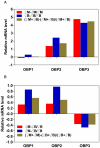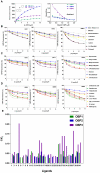Distinct expression profiles and different functions of odorant binding proteins in Nilaparvata lugens Stål
- PMID: 22174925
- PMCID: PMC3235172
- DOI: 10.1371/journal.pone.0028921
Distinct expression profiles and different functions of odorant binding proteins in Nilaparvata lugens Stål
Abstract
Background: Odorant binding proteins (OBPs) play important roles in insect olfaction. The brown planthopper (BPH), Nilaparvata lugens Stål (Delphacidae, Auchenorrhyncha, Hemiptera) is one of the most important rice pests. Its monophagy (only feeding on rice), wing form (long and short wing) variation, and annual long distance migration (seeking for rice plants of high nutrition) imply that the olfaction would play a central role in BPH behavior. However, the olfaction related proteins have not been characterized in this insect.
Methodology/principal findings: Full length cDNA of three OBPs were obtained and distinct expression profiles were revealed regarding to tissue, developmental stage, wing form and gender for the first time for the species. The results provide important clues in functional differentiation of these genes. Binding assays with 41 compounds demonstrated that NlugOBP3 had markedly higher binding ability and wider binding spectrum than the other two OBPs. Terpenes and Ketones displayed higher binding while Alkanes showed no binding to the three OBPs. Focused on NlugOBP3, RNA interference experiments showed that NlugOBP3 not only involved in nymph olfaction on rice seedlings, but also had non-olfactory functions, as it was closely related to nymph survival.
Conclusions: NlugOBP3 plays important roles in both olfaction and survival of BPH. It may serve as a potential target for developing behavioral disruptant and/or lethal agent in N. lugens.
Conflict of interest statement
Figures

 '' below the alignment, and other conserved residues were highlighted in gray.
'' below the alignment, and other conserved residues were highlighted in gray.





References
-
- Pelosi P. Odorant-binding proteins: structural aspects. Annals of the New York Academy of Sciences. 1998;855:281–293. - PubMed
-
- Blomquist G, Vogt RG. In Insect Pheromone Biochemistry and Molecular Biology. In Insect Pheromone Biochemistry and Molecular Biology. (eds. GJ Blomquist and RG Vogt), pp 3-18. Elsevier Academic Press, London; 2003. Biosynthesis and detection of pheromones and plant volatiles: introduction and overview.
-
- Vogt RG. Endocrinology. (LI Gilbert, K Iatro, S Gill eds). pp 753-804. Elsevier, London. ISBN; 2005. Molecular Basis of Pheromone Detection in Insects. In Comprehensive Insect Physiology, Biochemistry, Pharmacology and Molecular Biology.Volume 3.044451516X
-
- Xu P, Atkinson R, Jones DN, Smith DP. Drosophila OBP LUSH is required for activity of pheromone-sensitive neurons. Neuron. 2005;45:193–200. - PubMed
-
- Hallem EA, Dahanukar A, Carlson JR. Insect odor and taste receptors. Annual Review of Entomology. 2006;51:113–135. - PubMed
Publication types
MeSH terms
Substances
LinkOut - more resources
Full Text Sources

